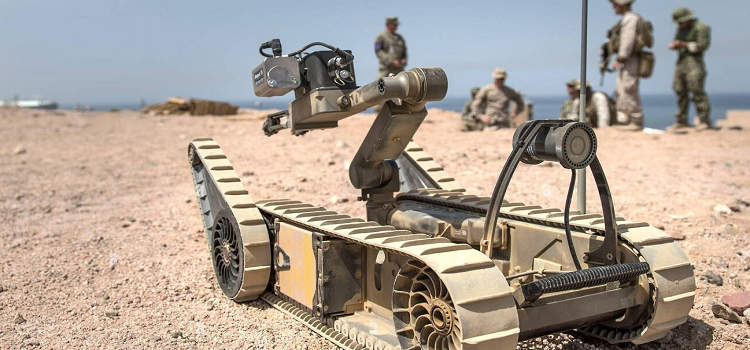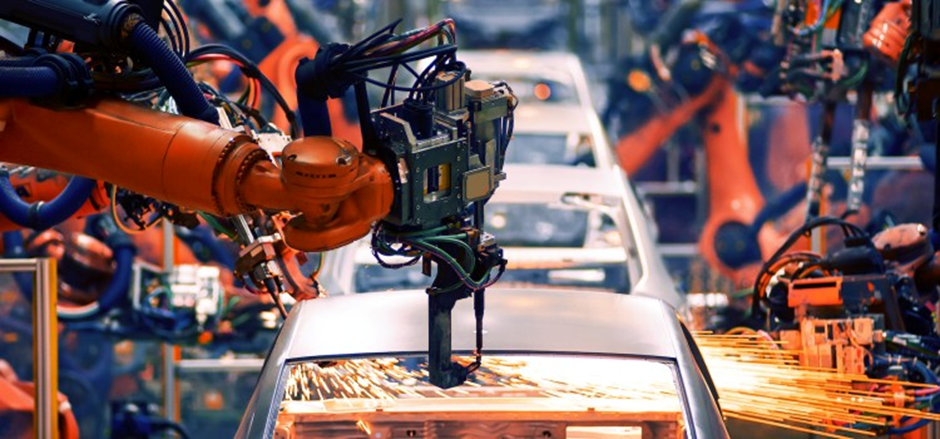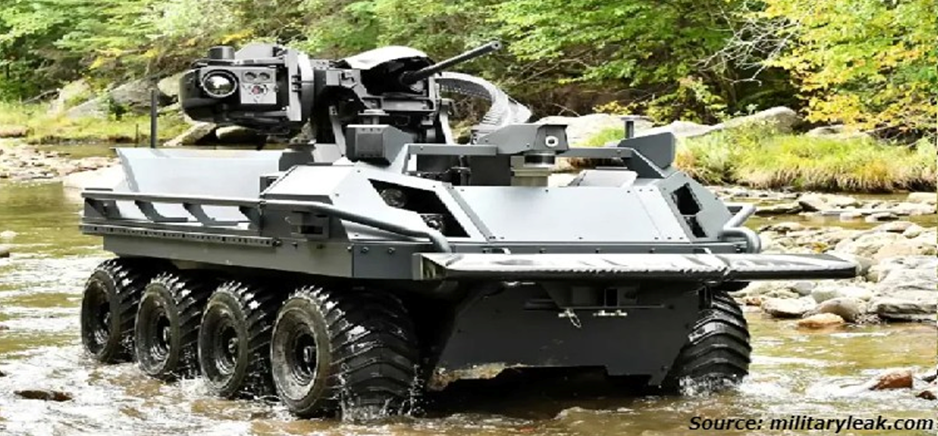Modern Technologies that Shape the Future of UGVs
17-Sep-2024

Introduction
The industry of unmanned ground vehicles (UGVs) brought together cutting-edge technology and innovative engineering. This led to the emergence of new frontiers in transportation, logistics, defense, and numerous other industries. UGVs are autonomous or remotely operated vehicles capable of executing tasks without human intervention. From compact robotic platforms for intricate manoeuvres to robust machines built for demanding applications, UGVs leverage artificial intelligence (AI), sensor technology, and robotics to enhance their capabilities and reliability.
One of the primary domains profoundly impacted by UGVs is transportation. These vehicles are revolutionizing the movement of goods and people, with applications such as last-mile delivery robots operating in urban environments and self-driving trucks handling long-distance cargo transportation. As a result, logistics processes are streamlined, efficiency is enhanced, and costs are reduced. Furthermore, UGVs have the potential to significantly improve road safety by eliminating human error and fatigue-related risks.
Beyond transportation and logistics, UGVs are proving invaluable in defense and security. Armed forces worldwide employ UGVs for reconnaissance, surveillance, and hazardous operations, providing enhanced capabilities while safeguarding the lives of personnel. UGVs also play a crucial role in search and rescue missions, disaster management, and handling hazardous materials, as they can access dangerous environments and execute critical tasks with precision and agility. This blog aims to uncover the latest advancements in UGV technology, examine the ethical and societal implications of their widespread adoption, and envision the future landscapes shaped by these remarkable machines.
Autonomous Navigation
UGVs are witnessing remarkable progress in autonomous navigation systems, enabling them to navigate complex terrains with precision and safety. Advanced sensors, computer vision, and machine learning algorithms empower UGVs to perceive their environment, adapt to changing conditions, and make intelligent decisions.
At the heart of autonomous navigation lies a network of sophisticated sensors that equip UGVs with an understanding of their surroundings. These sensors include cameras, Light Detection and Ranging (LIDAR), Radio Detection and Ranging (RADAR), and other proximity sensors. By capturing and processing data in real time, UGVs can create detailed maps of their environment, detect obstacles, and identify key features necessary for accurate navigation.
Computer vision algorithms are crucial in extracting meaningful information from the sensor data. UGVs can recognize objects, understand road markings, and interpret traffic signs by analyzing visual inputs. This enables them to navigate urban environments, follow predefined routes, and adapt to dynamic situations, such as pedestrian crossings, traffic congestion, and construction zones.
Machine learning algorithms enhance UGVs' ability to make intelligent decisions based on sensor inputs and contextual information. Through machine learning, UGVs can learn from past experiences and improve their navigation strategies. They can anticipate potential obstacles, predict the behavior of other vehicles or pedestrians, and optimize their trajectories for efficiency and safety.
Furthermore, advancements in UGV navigation systems have led to the development of robust path-planning algorithms. These algorithms enable UGVs to calculate optimal routes, considering distance, terrain conditions, and specific mission requirements. With precise path planning, UGVs can navigate challenging terrains, including rugged landscapes, uneven surfaces, and confined spaces, with utmost accuracy and reliability.
The continuous advancements in autonomous navigation systems have opened up a world of possibilities for UGVs across various industries. In transportation and logistics, UGVs with advanced navigation capabilities can efficiently navigate complex urban environments, deliver packages, and optimize supply chain operations. In defense and security, UGVs can autonomously patrol and survey large areas, identify potential threats, and support military operations.
As technology evolves, researchers and engineers push the boundaries of autonomous navigation even further. They explore advanced perception techniques, such as 3D mapping and object recognition, to enhance UGVs' understanding of their surroundings. Additionally, advancements in communication and connectivity enable UGVs to exchange information with other vehicles and infrastructure, facilitating collaborative navigation and creating a cohesive ecosystem of autonomous systems.
In May 2022, a leading robotics and autonomous systems developer Milrem Robotics launched a UGV called THeMIS Observe. This is an autonomous UGV designed for Intelligence, Surveillance, and Reconnaissance (ISR) operations. It is equipped with Milrem Robotics' Intelligent Functions Kit, which enables various autonomous capabilities. It has a follow-me function, which allows it to track and follow a designated target or operator without requiring direct control. This feature is particularly useful when a human operator must move around while the UGV remains focused on them, such as in military or security operations.
Multi-Mission Capabilities
The evolution of modern UGVs has led to the development of versatile platforms that can serve multiple purposes across diverse industries. These advanced UGVs are designed to adapt and perform various missions, making them invaluable assets in various scenarios.
One of the key strengths of modern UGVs is their ability to fulfill critical tasks in fields such as surveillance, inspection, search and rescue, cargo transport, and firefighting. Equipped with advanced sensor systems, robust navigation capabilities, and autonomous functionalities, these UGVs excel in performing complex and demanding missions.
In surveillance, UGVs act as efficient and reliable eyes on the ground. They can navigate challenging terrains, access hard-to-reach areas, and gather real-time visual and sensor data. With their autonomous navigation capabilities, UGVs can conduct persistent surveillance, monitor critical infrastructure, and provide situational awareness in urban and remote environments. Similarly, for inspection purposes, UGVs offer a safe and cost-effective solution. They can autonomously inspect structures, pipelines, and hazardous environments, reducing the need for human intervention in potentially dangerous situations. Equipped with specialized sensors, UGVs can detect anomalies, assess structural integrity, and precisely perform detailed inspections.
Moreover, UGVs are vital in locating and assisting distressed individuals in search and rescue operations. With mobility and autonomy, UGVs can navigate disaster-stricken areas, search for survivors in the rubble, and relay crucial information to rescue teams. These UGVs are reliable partners in saving lives and minimizing risks during critical missions.
UGVs also excel in cargo transport, efficiently moving goods and supplies in diverse environments. With their autonomous navigation systems and robust payload capacities, these UGVs optimize logistics operations in industries such as e-commerce, manufacturing, and warehousing. They can navigate complex pathways, adapt to changing environments, and ensure timely and secure deliveries.
Furthermore, UGVs are increasingly employed in firefighting operations, aiding firefighters in hazardous situations. Equipped with specialized equipment, these UGVs can access confined spaces, assess fire conditions, and provide essential support in extinguishing flames. By minimizing human exposure to risks, UGVs enhance overall safety and effectiveness in firefighting efforts.
For instance, in April 2023, Milrem Robotics introduced specialized UGVs in Latin America for firefighting and combat purposes. The company stated that utilizing their THeMIS Combat and Multiscope Rescue UGVs in firefighting operations can revolutionize how fires are handled. This will lead to faster response times, improved accuracy in fire suppression, and reduced risks to human lives. In military and security contexts, combat UGVs can augment human capabilities, enhance situational awareness, and enable the efficient deployment of resources.
Swarming Technology
Swarming technology uses coordinated teams of UGVs that employ swarm intelligence to accomplish complex missions efficiently. Swarm intelligence is inspired by the collective behavior observed in natural swarms, such as flocks of birds or schools of fish, where individual agents work together without centralized control to achieve common goals.
When UGVs are equipped with swarm capabilities, they can distribute tasks, share information, and collaborate seamlessly. This enables them to work as a unified system, exhibiting collective intelligence that surpasses the capabilities of individual robots. Swarming technology in UGVs offers several benefits and applications. Regarding task distribution, swarming UGVs can allocate specific tasks based on individual capabilities, allowing for the simultaneous accomplishment of multiple objectives and increasing overall efficiency. Information sharing among UGVs within the swarm enhances situational awareness and decision-making by enabling real-time data exchange, including sensor data, maps, and observations. Collaborative coordination enables swarming UGVs to synchronize actions, movements, and behavior, facilitating complex tasks and manoeuvres. Swarming technology enhances efficiency and effectiveness in critical scenarios, enabling rapid task execution, accurate performance, and adaptability to dynamic situations.
Additionally, the applications of swarming technology extend beyond military and security domains to industries such as transportation, logistics, agriculture, and construction, where swarming UGVs can optimize routes, coordinate operations, and enhance precision agriculture practices.
Conclusion
Continuous advancements in the UGV industry hold immense potential for economic growth, job creation, and technological advancements. UGVs possess the potential to revolutionize transportation, logistics, defense, agriculture, and various other sectors. Their capacity to navigate challenging terrains, perform complex missions, and adapt to diverse environments is reshaping traditional approaches to problem-solving and task execution.
The future of UGVs shines brightly, propelled by ongoing research, engineering breakthroughs, and collaborations among stakeholders. These advancements pave the way for groundbreaking innovations in the near future. Enhanced autonomous capabilities, swarming technology, and improved connectivity provide a glimpse of the exciting developments to come. However, it is of utmost importance to address ethical considerations, establish robust regulatory frameworks, and ensure responsible deployment of UGVs to maximize this technology's benefits while minimizing potential risks.
About the Author
 Shankar Nishant is a researcher at Next Move Strategy Consulting with a cumulative experience of more than four years. Shankar is enthusiastic about new technology, enjoys working with diverse global clients, and has delivered numerous market reports in multiple domains. He can be reached at info@nextmsc.com
Shankar Nishant is a researcher at Next Move Strategy Consulting with a cumulative experience of more than four years. Shankar is enthusiastic about new technology, enjoys working with diverse global clients, and has delivered numerous market reports in multiple domains. He can be reached at info@nextmsc.com
Add Comment
Related Blogs
Major Industry Leaders and Their Impact on the Automotive Robotics Market
Automotive robotics market expected to experience rapid grow...
Tech Titans Transforming AI Robots: IBM, Intel, and Microsoft's Influence
According to Next Move Strategy Consulting, the AI Robots Ma...
UGVS and the Power Players: Genetal Dynamics, Qinetiq, and Boston Dynamics
According to Next Move Strategy Consulting, the UGV Mar...










